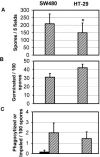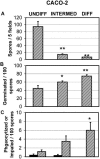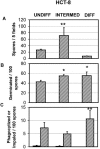Apical spore phagocytosis is not a significant route of infection of differentiated enterocytes by Encephalitozoon intestinalis
- PMID: 16239574
- PMCID: PMC1273909
- DOI: 10.1128/IAI.73.11.7697-7704.2005
Apical spore phagocytosis is not a significant route of infection of differentiated enterocytes by Encephalitozoon intestinalis
Abstract
Encephalitozoon intestinalis is a microsporidian species that infects the intestinal mucosal epithelium, primarily in immunodeficient individuals. The present study employed undifferentiated and differentiated human colonic carcinoma cell lines to determine if this parasite species infected polarized epithelial cells by spore phagocytosis or by impalement with the deployed spore polar tube. Apical surface spore attachment differed between cell lines such that SW480>HT-29>Caco-2>HCT-8, with attachment being greater to undifferentiated Caco-2 cells than differentiated cells and greater to partially differentiated HCT-8 cells than differentiated HCT-8 cells. Attachment was inhibited by chondroitin sulfate A, suggesting that it was mediated by host cell sulfated glycoaminoglycans. Infection rates 3 days postinfection paralleled spore attachment in the various cell lines. The undifferentiated cell line SW480 and undifferentiated Caco-2 and HCT-8 cells exhibited modest spore phagocytosis while the more differentiated cell line HT29 and differentiated Caco-2 and HCT-8 cells did not. All cell lines were impaled by the polar tubes of germinating spores. When normalized to the number of spores attached to the apical membrane, such impalement was greatest in the more differentiated Caco-2 and HCT-8 cells. The host cell apical surface influenced parasite spore germination, as in populations of large undifferentiated Caco-2 cells to which >3 spores had attached, the frequency distribution of the percentages of spores germinated per cell was bimodal, indicating that the surface of some cells favored germination, while others did not. This study suggests that phagocytosis is not a biologically significant mode of infection in differentiated intestinal epithelial cells.
Figures







Similar articles
-
Role of sulfated glycans in adherence of the microsporidian Encephalitozoon intestinalis to host cells in vitro.Infect Immun. 2005 Feb;73(2):841-8. doi: 10.1128/IAI.73.2.841-848.2005. Infect Immun. 2005. PMID: 15664924 Free PMC article.
-
Actin mediates Encephalitozoon intestinalis entry into the human enterocyte-like cell line, Caco-2.Microb Pathog. 2000 Feb;28(2):51-8. doi: 10.1006/mpat.1999.0329. Microb Pathog. 2000. PMID: 10644491
-
Effects of host temperature and gastric and duodenal environments on microsporidia spore germination and infectivity of intestinal epithelial cells.Parasitol Res. 2008 Dec;104(1):35-42. doi: 10.1007/s00436-008-1156-4. Epub 2008 Aug 27. Parasitol Res. 2008. PMID: 18751726 Free PMC article.
-
Characterization and function of the microsporidian polar tube: a review.Folia Parasitol (Praha). 1998;45(2):117-27. Folia Parasitol (Praha). 1998. PMID: 9684322 Review.
-
Pathogenesis of human enterovirulent bacteria: lessons from cultured, fully differentiated human colon cancer cell lines.Microbiol Mol Biol Rev. 2013 Sep;77(3):380-439. doi: 10.1128/MMBR.00064-12. Microbiol Mol Biol Rev. 2013. PMID: 24006470 Free PMC article. Review.
Cited by
-
Cyclophosphamide Treatment Mimics Sub-Lethal Infections With Encephalitozoon intestinalis in Immunocompromised Individuals.Front Microbiol. 2019 Sep 25;10:2205. doi: 10.3389/fmicb.2019.02205. eCollection 2019. Front Microbiol. 2019. PMID: 31608035 Free PMC article.
-
Human microsporidian pathogen Encephalitozoon intestinalis impinges on enterocyte membrane trafficking and signaling.J Cell Sci. 2021 Mar 5;134(5):jcs253757. doi: 10.1242/jcs.253757. J Cell Sci. 2021. PMID: 33589497 Free PMC article.
-
Structural and functional characterization of a putative polysaccharide deacetylase of the human parasite Encephalitozoon cuniculi.Protein Sci. 2009 Jun;18(6):1197-209. doi: 10.1002/pro.128. Protein Sci. 2009. PMID: 19472335 Free PMC article.
-
Caco-2 cell acquisition of dietary iron(III) invokes a nanoparticulate endocytic pathway.PLoS One. 2013 Nov 21;8(11):e81250. doi: 10.1371/journal.pone.0081250. eCollection 2013. PLoS One. 2013. PMID: 24278403 Free PMC article.
-
Invasion and intracellular survival by protozoan parasites.Immunol Rev. 2011 Mar;240(1):72-91. doi: 10.1111/j.1600-065X.2010.00990.x. Immunol Rev. 2011. PMID: 21349087 Free PMC article. Review.
References
-
- Barry, W. K. 2003. Molecular characterization of Encephalitozoon Microspora) replication kinetics in a murine intestinal cell line. J. Eukaryot. Microbiol. 50:169-174. - PubMed
-
- Chantret, I., A. Barbat, E. Dussaulx, M. G. Brattain, and A. Zweilbaum. 1988. Epithelial polarity, villin expression, and enterocytic differentiation of cultured human colon carcinoma cells: a survey of twenty cell lines. Cancer Res. 48:1936-1942. - PubMed
-
- Chen, X. M., P. L. Splinter, P. S. Tietz, B. Q. Huang, D. D. Billadeau, and N. F. LaRusso. 2004. Phosphatidylinositol 3-kinase and frabin mediate Cryptosporidium parvum cellular invasion via activation of Cdc42. J. Biol. Chem. 279:31671-31678. - PubMed
-
- Cossart, P., and P. J. Sansonetti. 2004. Bacterial invasion: the paradigms of enteroinvasive pathogens. Science 304:242-248. - PubMed
Publication types
MeSH terms
Grants and funding
LinkOut - more resources
Full Text Sources

